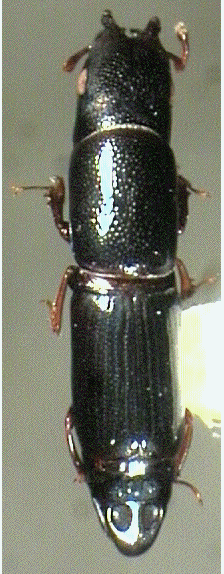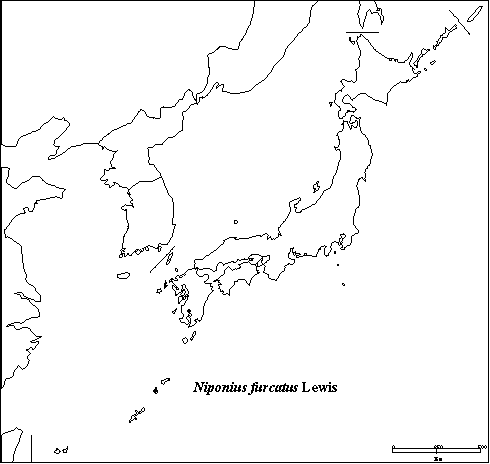Niponius furcatus Lewis, 1885b: 333 [Japan, Yuyama]; Gardner,1926: 3 1935: 5 [catalogued]; Kryzhanovskij and Reichardt, 1976: 77 [key]; Hisamatsu, 1985: 219, pl. 40, fig. 4.
Japanese name: Fushi-tsuno-hoso-emma-mushi.
Niponius furcatus Lewis, 1885b: 333 [Japan, Yuyama]; Gardner,1926: 3 1935: 5 [catalogued]; Kryzhanovskij and Reichardt, 1976: 77 [key]; Hisamatsu, 1985: 219, pl. 40, fig. 4.
Japanese name: Fushi-tsuno-hoso-emma-mushi.
The narrow form of this species, the divergent direction of the projection on the epistoma, and the different form of the abdominal sulci separate it form the others."
Description. Biometric data are given in Table 6. Body cylindrical, slender. Cuticle shining, black; tarsi, antennae and projection of epistoma dark rufopiceous.
Projections of epistoma moderately stout, long and divergent anteriorly (Fig. 42A, E), its apex strongly carinate and dorsal surface with two transverse carinae. Head densely covered with moderate punctures and with several weakly rugae on base of the projection, the punctures becoming coarser on basal two-thirds, where they are separated by two to three times their diameter.
Pronotum completely with marginal stria on lateral side, the stria well carinate; surface densely covered with punctures, the punctures various in size from fine to large (the large punctures are five times as large as the fine ones) and becoming finer around margin.
Marginal elytral stria on epipleura of elytra complete and carinate, its basal end extending inwardly along anterior margin of elytron and united with basal end of sutural stria, its apical end attaining to the apical fifth of elytron. All dorsal striae absent, but there are rows of coarse and dense punctures; intervals among the rows sparsely covered with coarse punctures, the punctures becoming denser apically.
Propygidium (Fig. 42D) with four large, longitudinal oblong, shallow and transversely placed foveae, sometimes these foveae fused; surface sparsely covered with punctures, which are as coarse as elytral ones and separated by two to three times their diameter. Pygidium (Fig. 42D) with a large, round and shallow fovea behind each basal corner; inside of the fovea sparsely covered with coarse punctures; surface coarsely punctate, the punctures separated by their diameter and becoming finer and denser apically and laterally.
Antennal grooves deep under the eyes, and deep and longitudinal foveae on basal half of underside of head (Fig. 42B). Mid line strongly impressed on apical half, but not impressed near the apical margin of the head. Surface of underside of head evenly scattered with fine punctures on apical half; on basal half very sparsely clothed with fine punctures, the punctures becoming coarser and denser near the basal margin.
Prosternal lobe (Fig. 42C) transverse and narrow, its anterior margin densely with hair. Prosternal keel narrow, with carinal stria on basal three-fourths, the striae deeply impressed and slightly convergent basally; surface of keel evenly and finely punctate.
Mesosternum longitudinally sulcate on mid line; surface sparsely covered with moderate punctures which are separated by two to three times their diameter, and with large punctures near basal margin. Meso-metasternal suture well impressed and complete. Metasternum shallowly sulcate on mid line; lateral metasternal striae strongly carinate and divergent posteriorly. Intercoxal disk of metasternum sparsely covered with moderate sized punctures. Lateral disk densely covered with large, round and shallow punctures on basal third, the punctures becoming finer and sparser posteriorly.
Intercoxal disk of 1st abdominal sternum striate on basal two-thirds on each lateral side, and evenly and moderately punctate, the punctures separated by two to three times their diameter.
Protibia slender and with two denticles on outer margin.
Table 6. Biometric data of Niponius furcatus Lewis.
------------------------------------------------------------------
HOW 0.44-0.48 (0.45±0.010) 2
HW 0.73-0.76 (0.75±0.010) 2
PW 0.79-0.85 (0.82±0.021) 2
PL 1.14 (1.14 ) 2
EL 1.14-1.24 (1.19±0.036) 2
EW 0.85-0.89 (0.87±0.016) 2
ProW 0.50 (0.50 ) 2
ProL 0.26 (0.26 ) 2
PyL 0.44-0.48 (0.45±0.010) 2
PTL 0.56-0.57 (0.56±0.005) 2
MSTL 0.48-0.50 (0.49±0.005) 2
MTTL 0.47-0.50 (0.48±0.010) 2
----------------------------------------------------------------------
Remarks. Niponius furcatus is characterized by the narrow body, the diverse
projections of the epistoma and the four foveae on the propygidium.
[Kyûshû] <Kagoshima-ken> 1Åä, Kirishima-Jingû, 9/vi/1981, T. & T. Nakane leg. (NA).
[Nansei Isles.] <Tokuno-shima Is.> 1Åä, Mikyô, 25/vii/1963, Y. Kurosawa leg.
<? Shikoku, Kôchi-ken> 1 ex., Wada, Taishô-mura, 4/x/1936,
no collecters name, collected from Tsuga sieboldi. (NSMT: Kôno collection,
No. NSMT-C-23669).
